Updated: 09-Aug-2018
-Actually they were the "Talleres Nacionales de Construcciones Aeronáuticas" (see). They built engines under license and some autochthonous, although derived from the previous ones like the "Aztatl". And in TNCA.
-It is also known by the acronym in English as NAF (National Aviation Factory) was founded in 1915 and the first engines to be built were the Anzani 6-cylinder giving 80 hp, precisely the one that received the name of "Aztatl", radial.
-In 1917 it acquired a license from Hispano-Suiza, to build their engines. It also acquired all the necessary tools.
-They made the 80 hp LeRhone, the 160 hp Mono-Gnome and the 185 hp BMW.
-It is very easy to confuse the two FMA: The one in Argentina and the one in Mexico, but a slight nuance distinguishes them, because Argentina is "Fabrica Militar de Aviones" and the Mexican one is "Fabrica Militar de Aviación".
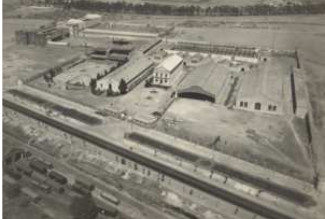
"The factory"
-The Mexican FMA is also known by the acronym in English NAF (National Aviation Factory) but as it happens nearly always, its most common name has been TNCA or "National Workshops of Aeronautical Constructions".
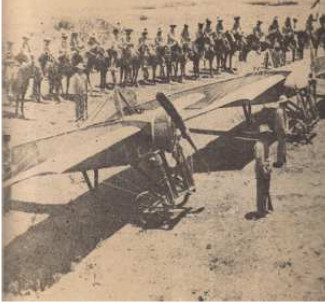
"Aircraft of the Mexican civil war"
-Mexico already used aviation in its 1915 civil war, with American and French aircraft. At that time the Workshop for maintenance of these devices was started. There is information that they still have this maintenance workshop for current aviation. But in the question of engines, which is what interests us, they acquired licenses to build engines in their country: Le-Rhone 80 hp, Gnome 80 hp, Anzani 90 hp, BMW 180 hp and especially the Hispano-Suiza of 150 -160 HP.
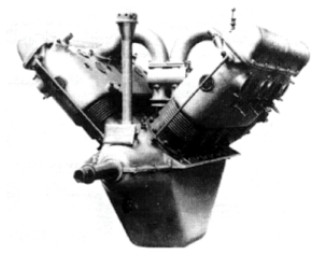
"Second H-S model built in Barcelona"
-The people in charge of TNCA contacted the management of Hispano-Suiza in Barcelona (Spain), who were Mateu and Birkgit. They obtained the license with a large assortment of complete tools for its construction. In addition, two Type-34 engines, still with mixed cooling and air cooling fins under the cylinder block.
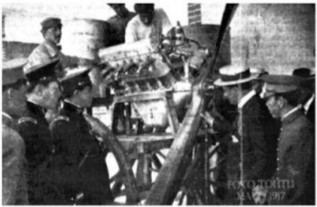
“A Hispano-Suiza from the Mexican order” (photo Tohtli 1917, SMEAL)

"The TNCA Microplano-Veloz" (MAH)
-However, they made various types of propellers under the ANAHUAC brand, which were used by all engine models.
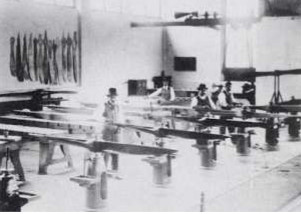
"Anahuac propeller construction workshop"
-But even more interesting are the engines of their own design, the "Trebol", the "Aztatl" and the "SS Mexico".
-Here were involved Fco. Santarini as the company's superintendent as well as Mr. Vilasana.
-Below I deal with the Mexican indigenous projects starting with the best known, the "Aztatl" engine.
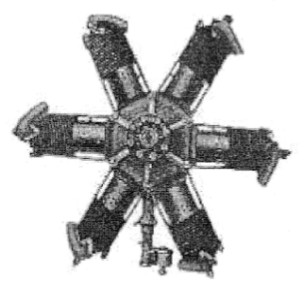
"Aztatl's first version"
-This engine was based on the Anzani engines that were installed on the aircraft they received from France earlier, although referred to the 6-cylinder radia that gave 80/90 hp, manufactured by TNCA in 1917.
-The first version had auxilary exhaust ports at the base of the cylinders.
The ribs of the central block are considerably thicker.
"Without exhaust ports at the cylinder base and on the head the bifurcated exhaust"
NOTE. Information taken from the blog <aerospaceengines.blogspot.com> by the same author of this A-Z.
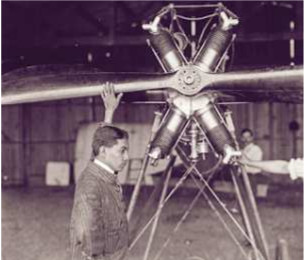
"Engineer Vilasana next to an Aztatl with an Anahuac propeller"
-The name "Aztatl" comes from "Garza Blanca" in the Nahuatl language.
-One new photos show us the detail of the cylinder with a strap or clamp, as if they were covering the secondary exhaust ports.
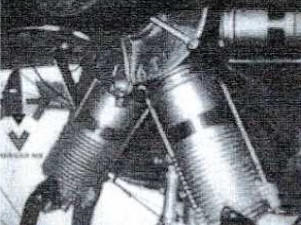
“The cover of the exhaust ports are clearly visible”
(Ports covered by metal strips)
-Other information is that the "Aztatl" is the 6-cylinder Anzani, but yes, built in Mexico.

"Monoplane with more advanced Aztatl"
-The "Trebol" engine from TNCA (FMA-Mex.) from the year 1916, is based on the Anzani three-cylinder inverted-Y-engine.
-Although it is more similar to Szekely's SR-3 model with the "temporal paradox" that appeared in 1928.
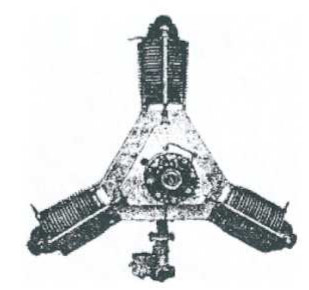
“Trébol" (A-Z)
-It was installed on aircraft of the same brand FMA (TNCA). In the photo below we see Mr. Vilasana together with his "Trebol".

"Vilasana with his Trébol"
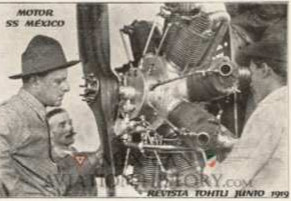
“Photo with Vilasana in front of an SS México” (by Thotli via MAH)
-Another engine was the "SS Mexico". Here the author has a doubt, since, according to his personal files the "SS Mexico" was a company set up in Mexico by the Hispano-Suiza from Barcelona, in 1916 (in fact a subsidiary) probably arising from the manufacturing agreements under license for the V8 engines and to introduce their engines in that country.
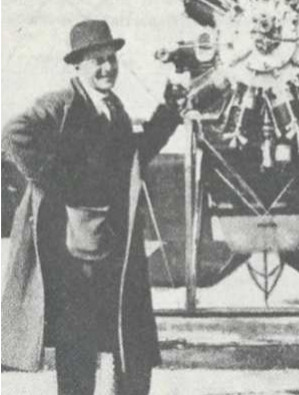
"Superintendent Santarini in front of an SS Mexico"
-The "SS Mexico" was a 10-cylinder, double-row radial engine that gave 150 hp.
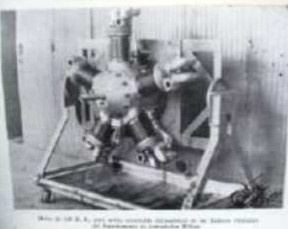
"The SEA radial engine, built by TNCA"
-Now, as a curiosity, there is a 150 hp Hispano-Suiza engine that was installed on an aircraft from the TNCA C-series, and that can be seen at the FAM Museum in Mexico. It seems to have a high water-block without fins, which is not related to the two engines mentioned above.
-In addition we have information of another engine that appeared in a SMEAL publication, with a photo of "Tohtli" (old Mexican aeronautical magazine) that came to us via Oscar Fr. Alvarado. It is a radial with 5 cylinders designed by engineer SEA and built at the TNCA factory.
Engines of FABRICA MILITAR DE AVIACION
Model: Aztatl (Anzani 6 cyl, Lic.)
Arquitecture: 6-cylinder Radial
Cooling:
Total Displacement:
Bore / Stroke:
Power: 90 HP
Weight:

"FMA, Aztatl's first version"
Model: BMW, 185 HP (Lic.)
Arquitecture:
Cooling:
Total Displacement:
Bore / Stroke:
Power: 185 HP
Weight:
Model: Hispano-Suiza V8, (Lic.)
Arquitecture: 8-cylinder V-Engine
Cooling:
Total Displacement:
Bore / Stroke:
Power:
Weight:

"Second H-S model engine built in Barcelona"
Model: Le-Rhone, 80 HP (Lic.)
Arquitecture: 9-cylinder Rotary
Cooling: Air
Total Displacement:
Bore / Stroke:
Power: 80 HP
Weight:
Model: Mono-Gnome, 160 HP (Lic.)
Arquitecture: 9-cylinder Rotary
Cooling: Air
Total Displacement:
Bore / Stroke:
Power: 160 HP @ rpm
Weight:
Model: SEA, 5 radial, 125 cv. Ver TNCA
Arquitecture: Radial
Cooling:
Total Displacement:
Bore / Stroke:
Power: 125 HP
Weight:

"SEA radial engine built by TNCA"
Model: SS Mexico
Arquitecture: 10-cylinder Radial
Cooling:
Total Displacement:
Bore / Stroke:
Power: 150 HP
Weight:
Model: Trebol, 3 cyl. radial
Arquitecture: 3-cylinder Inverted Y-engine
Cooling:
Total Displacement:
Bore / Stroke:
Power:
Weight:

"FMA Trébol engine"


